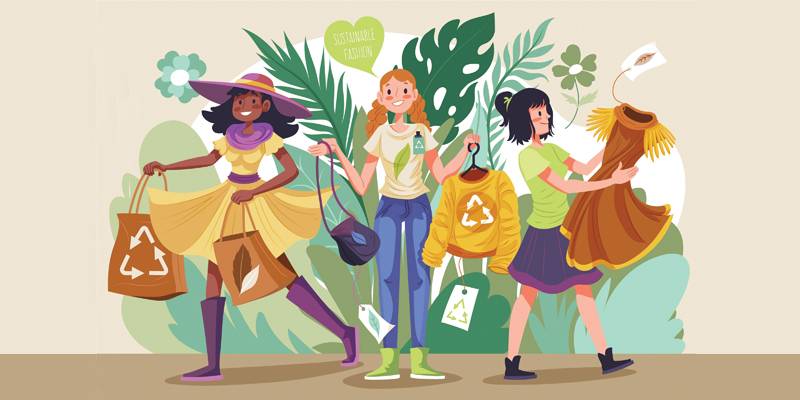A beginner’s guide to sustainable fashion

Climate change is real as our environment is getting affected every passing day, and we humans are responsible for our actions that have led to such consequences. Terms such as Global Warming, Climate Change, Water Scarcity, Water Pollution, and Air Pollution, among others, have become a part of our lives. So much so, that, inadvertently, we have become more conscious about how we can help save the environment: by replacing plastic bags with reusable bags, by trying not to waste too much food, and by saving as much electricity and water as possible. But wait! What about the clothes we wear? Is there a connection between what we wear and the environment?
To be honest, there’s a big connection. Look at what you’re wearing right now while you read this article. You might be sitting at home in your pyjamas or toiling around in office wear, but that particular piece of clothing might take around 300 years to fully decompose in the soil. And this is just the tip of the iceberg. To top it all, it takes 2,700 litres of water to make one cotton t-shirt. Basically, this is the amount of water a person drinks in 2.5 years, and every year almost two billion cotton t-shirts are sold worldwide.
Rest, you can do the math. Also, almost 100 billion garments are purchased every year around the world, and the chances are that a specific purchase may be worn just seven times before being tossed out. Almost 93% of these used clothes end up in landfills. Since our clothes are mostly made up of synthetic fibres — 60% to be exact — they are non-biodegradable.
Synthetic fibres aren’t the only problem. Where the raw material is sourced from and how the clothes are manufactured, these things contribute a lot to the pollution levels. During the manufacturing of clothes, a lot of chemical and synthetic dyes are used to give them a polished look. Every year, almost 50,000 tons of dye is discharged into global water systems from textile industries. So, it’s not surprising that the fashion and textile industry is the second most polluting industry in the world after oil and gas.
There is no denying that the current situation is really bad, and we are staring at adverse climate changes threatening to pull down the world as we know it. However, no individual is going to change the world by themselves, but if each person starts to make small changes and contribute their bit, it can lead to a revolution. From the manufacturers of the fabric to the consumer, there is a responsibility to think about how to make them, how to buy them, and, finally, how to dispose of them.
The United Nations says that the fashion industry is responsible for 10% of global greenhouse emissions annually. Every item you tick off your cart is invariably affecting the environment. However, the purpose of this article isn’t to scare you but to make you aware. It’s not like we’ll stop wearing clothes! 80% of the carbon footprint of any item is post-purchase. We should think about how we can look after an item more sustainably.
You can start by washing your clothes at a cooler temperature for 90% of the energy that washing machines use goes on heating up the water, and a paltry 10% is used to run the machinery. Clothes washed in cold water also tend to keep their shine and shape for longer. In fact, 95% of the clothing we chuck away could have a second life. Instead, we’ve gotten into this throw-away culture without realising how detrimental it is to the planet.
If you’re sick of the clothes you own, ask if any of your friends want to use them —except, of course, items like underwear and intimates. This way you can easily recycle your clothes and have different options to wear too. A better answer and solution is ‘Sustainable Fashion’. By sustainable fashion, we mean those clothes which are not made out of synthetic fibres such as nylon, polyester, or acrylic but are made from eco-friendly fibres, which can either be entirely from natural resources such as wood pulp, hemp, jute, coconut, bananas, pineapples, etc. or can be a mix of both natural and synthetic fibres, which put less strain on the environment and can actually decompose in a shorter time span. Many renowned brands are currently moving towards sustainable fashion.
This change is happening because we’ve become conscious of our environment. Taking a cue from established brands, many retail chains have also started their own collections made out of sustainable fibres. Among many makers of sustainable fibres, an Austrian company produces a certain variety which is made out of wood pulp and is called EcoVero. This fibre can actually put 50% less strain on the environment and can decompose completely within just a few months. Most of the clothes which any brands have right now are not made out of sustainable fibres. But that’s how our economy works, right? It’s about demand and supply as they also have to maintain their financial viability
While many brands are slowly moving towards sustainable fashion, maybe we, as consumers, can demand eco-friendly clothing? And who knows, if we all collectively ask for sustainable clothes, maybe in the near future, all brands might just succumb to our demands, or they might just be motivated to look at sustainable fashion as the norm rather than an exception. Won’t that be nice? Fast fashion is the product of unnecessarily large amounts of garments. Fast fashion is out. It’s about looking after what we have and thinking about what already exists. You don’t have to give up your glamour to be sustainable. There are things that have already been made that we can continue to enjoy in a healthy way. You don’t necessarily have to buy less, but you can definitely buy smarter or buy kinder. It’s about being better, doing less harm and more good.
Fashion is there to make you feel good, and through the search for ease and convenience, we’ve kind of lost that sense of human instinct which leads to creativity. Take something that is already in existence and change it to make something new. Till then, when you’re out shopping, and you want to buy some good clothes but also want to save the environment, just ask yourself, “Have you checked the tag?”






